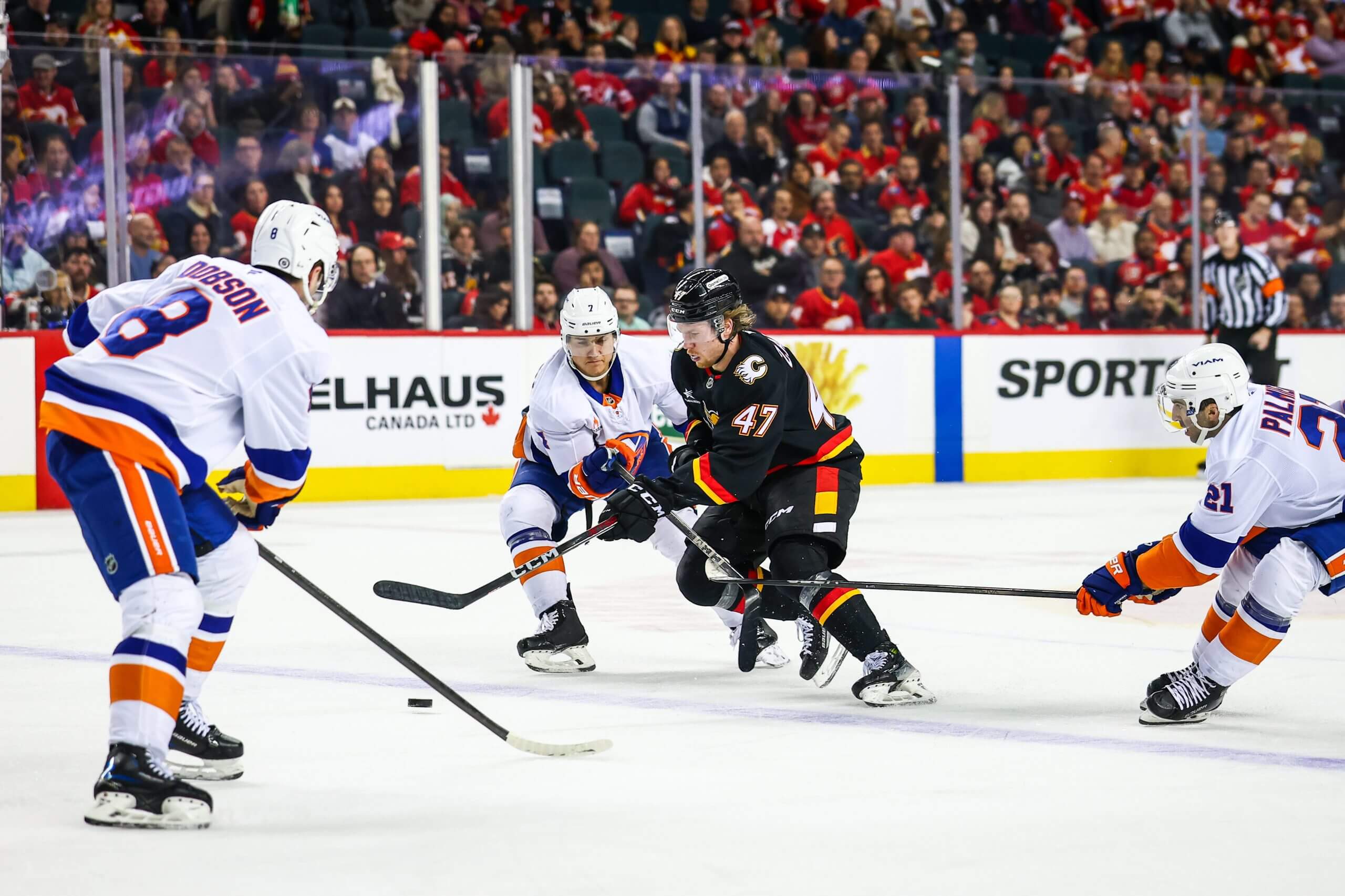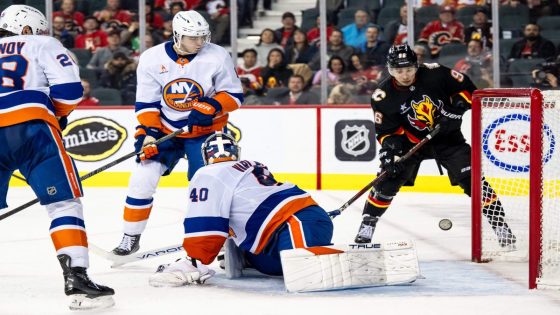You could make a list of the things the 2024-25 New York Islanders do well, then make a list of the things they don’t do well. The two lists would probably come out pretty even, which makes dissecting this team awfully confounding.
Are they good but unlucky? Bad but plucky? You can sum up this team through 19 games quite simply.
They’re the definition of mediocre.
I’ll throw some data at you in this piece, I’ll discuss some options for change — both minor and more drastic — that could pull the Islanders out of their rut. But the fundamental truth is they are 7-7-5, a record that speaks volumes without even looking too deeply under the hood. For three and a quarter seasons now, the Islanders have played mostly close games, lost a bunch and done so in maddeningly predictable ways, as that five at the end of the record line tells you.
Tuesday’s 2-1 shootout loss to the Flames in Calgary was more of the same: A couple of decent road periods, not enough scoring finish off enough high-danger chances to produce more than one goal, an untimely penalty, a power-play goal against and then a skills-competition point lost.
Yes, this Islanders team is fighting through important injuries. Yes, they are truly never out of a game, which speaks to the Trotzian DNA that still exists in this group going back seven years now. And yes, they are a pretty good five-on-five team, which again shows the foundation that Barry Trotz built and Patrick Roy has rekindled.
But it’s not enough. The Metro Division is separating quickly this season and the Islanders are being left behind, already knowing before Thanksgiving that it will be another mad dash to one of the last few playoff spots.
This isn’t progress. This isn’t success. This is mediocrity, the dreaded mushy middle that NHL teams have to break free from to have any chance at being a real contender.
Sorry to start off on such an overarching downer, but here we are. Let’s dig in a bit further with some observations over the past week.
Another disappointing western Canada swing
Two seasons ago, the Islanders went through Seattle, Vancouver, Edmonton and Calgary in early January. They lost three of four, kicking off a 1-7-3 slide that prompted Lou Lamoriello to swing the Bo Horvat trade.
Last season, the Isles made this western Canada-plus-Seattle trip at around the same time, mid-November. A shootout win in Calgary salvaged a 1-1-2 road trip and snapped a seven-game winless streak. Two months later, Roy replaced Lane Lambert.
There’s still a stop in Detroit on Thursday, but this trip through the Canadian Rockies has produced yet another blah result, with a good performance in Vancouver canceled out by blown leads in Seattle and Calgary and a desperation point earned in Edmonton. The fact is the Islanders haven’t won twice in western Canada since the Doug Weight era, so this is not a new trend — the 2019-20 regular season ended in Calgary with the COVID-19-induced shutdown of the league and the limited 2020-21 schedule meant no trip that season.
But this season’s swing and last season’s swing looked very similar. Last season, the Lambert-led Isles coughed up third-period leads in Vancouver and Seattle to lose in overtime and a shootout; they coughed up a third-period lead twice in Calgary, too, but got the extra point to go 6-6-5 coming back home.
Now it’s 7-7-5 after familiar letdowns.

Special teams mess
In addition to giving away leads late, the Isles, like last season, have appalling special teams. The power play is where they miss Mat Barzal and Anthony Duclair most of all, even though the power play wasn’t exactly top 10 with those guys healthy the first few weeks of the season. But the units now have very little cohesion missing two of their best workers.
With the way the Islanders have been able to play and produce at five-on-five, the power play being subpar would be survivable if the penalty kill weren’t, yet again, a total wreck.
Here’s a stat that will make you scream: The Islanders have spent the least time short-handed of any NHL team since the start of last season and have taken the second-fewest minors since the start of 2023-24, yet are by far the worst team at killing penalties in the league over the last 101 games.
Another stat: The Isles currently rank second in the league on the PK in fewest expected goals allowed.
And one more: Since the start of last season, the Islanders have a better kill rate when down two men (8-for-10, 80 percent) than they do down one man (188-for-262, 71.8 percent).
Tuesday night was a microcosm. Not a great penalty taken by Scott Mayfield, but teams take penalties, usually a few of them, every game. Nearly a full kill, but not quite. And an opposing power play that gets the Islanders moving inside their own zone, which is where too many of their failures are occurring.
Is there a PK guru out there who can give the Isles a boot camp session or two? Paging Frans Nielsen and Johnny Boychuk! (Actually, Boychuk works for the Isles now, so he can give them some pointers.)
Defensive zone breakdowns and adjustments
Peeking at some data on scoring chances, I can see the Islanders are not giving up much off the rush or off turnovers, so their up-ice structure is good. Where they’ve struggled based on the data is in the D-zone, where they rank 27th in high-danger chances allowed.
When Roy came in, this was a point of emphasis — he memorably said he didn’t want the Islanders playing the “dice” style in their own end, he wanted quick man-on-man coverage with support to try and force turnovers and get up the ice with numbers. Whether the Islanders simply don’t have the personnel to successfully play that way or teams have figured out how to break them down, it’s the one area at 5v5 that isn’t a net positive for them.
Adam Pelech’s absence may hurt there. Isaiah George has been a remarkable story in his brief NHL run but he’s starting to falter a bit, as you might expect. Grant Hutton sat out Tuesday with Alex Romanov finally returning; Hutton’s on-ice xG hasn’t been bad, nor has Dennis Cholowski’s. Cholowski has added some offense in his meager minutes.
Romanov’s return should stabilize the D-zone a bit. Pelech, still a few weeks away, should help as well. But neither of those defensemen is an up-the-ice puck-mover, so the Isles’ transition offense may be stuck in neutral.
Mike Reilly’s extended absence due to heart surgery opens up a spot for that kind of defenseman. Cholowski should get first chance at it since George playing 12-13 minutes a night seems less than ideal — he should go back to AHL Bridgeport, as was the plan before all the injuries.
If the Islanders are looking around for third-pair help, there isn’t much. Marcus Pettersson is likely the biggest-name LHD who could be moved but why would the Isles, who currently sit tied with the Pittsburgh Penguins at 19 points, make such a big addition?
What changes can be made?
The Islanders have a couple players other teams would be interested in, most notably Brock Nelson. It just so happens Nelson is tied for the team lead with seven goals and centers the most consistent line the team has had all season, between Maxim Tsyplakov and fellow pending UFA Kyle Palmieri. Trading Nelson or Palmieri means you’re punting on the season.
Even with all the mediocrity, it’s hard to endorse that. The Islanders need a reset/retool badly but doing it in November when the team, despite the ugly record, actually sits on the edge of the playoff race means UBS Arena sits three-quarters empty for the rest of the year. If this team is still hovering around .500 by January, it’ll be realistic to think about moving Nelson, Palmieri, Jean-Gabriel Pageau and even one of Pelech or Ryan Pulock, if someone wants to take on those long-term deals midseason.
Nothing should be off the table. But for now, it’s not realistic or practical.
Which means all that’s left is watching and hoping this team can hold onto its leads, kill its penalties and win some games. After 101 games of pretty much the same show, it’s hard to know how that will come to pass.
(Photo: Brett Holmes / Icon Sportswire via Getty Images)





